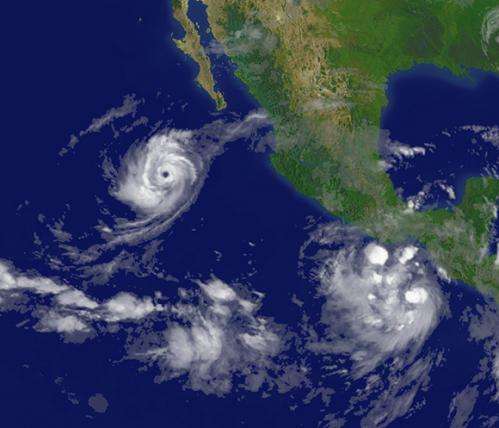Warm ocean water depth encourages development of Northeast Pacific hurricanes

(Phys.org) —Scientists have struggled to pinpoint the factors that control hurricane activity across years in the Northeast tropical Pacific. Previous studies focused mainly on the temperature at the water's surface as the key influence on developing hurricanes. The warmer the surface temperature, the more likely hurricanes intensified given the right atmospheric conditions. The Northeast Pacific, however, has some of the coldest water surface temperatures in the tropics yet places second around the world in the number of serious storms per year. Clearly, something else is at work. Now researchers at Pacific Northwest National Laboratory have discovered that the year-to-year variability in the depth of warm ocean water plays an important role in brewing up a storm's intensity.
Predicting the timing and path of hurricanes in the Northeast tropical Pacific Ocean has always been tough. While the tracks of these storms rarely fall over land, their remnant moisture contributes to nearly 30 percent of the annual precipitation in the southwestern United States and Mexico. Climate models predict that these regions will experience more prolonged droughts in the future, making it important to be able to predict how Northeast tropical Pacific Ocean hurricanes and their contribution to precipitation may be changing.
Scientists analyzed 28 years of hurricane track observations (1984 to 2011) from the National Hurricane Center and the U.S. Navy's Joint Typhoon Warning Center. They also looked at previous data and analyses from the National Centers for Environmental Prediction, Geophysical Fluid Dynamics Laboratory, and European Centre for Medium-Range Weather Forecasts for that 28-year period in the same area.
"The depth of the warm water plays a critical role in determining upper-ocean heat content, which ultimately translates into a source of energy for hurricane intensification. Our study looked at the impact of year-to-year variability in the surface warm-water depth, but potential long-term changes in surface warm-water depth due to global warming could also be important." said Dr. Karthik Balaguru, the PNNL atmospheric researcher who led the scientific team. "Understanding ocean variability and changes will help us target improvements needed in climate models. The ultimate goal is improving projections of future hurricane activities."
Scientists are working to identify the factors responsible for maintaining warm upper ocean waters in the Northeastern tropical Pacific that influence hurricane intensity. They also hope to evaluate how models, particularly those used in seasonal hurricane forecasting, fare in simulating those factors and whether improvements are needed.
More information: Balaguru K, LR Leung and J-H Yoon. 2013. "Oceanic Control of Northeast Pacific Hurricane Activity at Interannual Timescales." Environmental Research Letters 8(4): 044009. DOI: 10.1088/1748-9326/8/4/044009
Journal information: Environmental Research Letters
Provided by Pacific Northwest National Laboratory



















